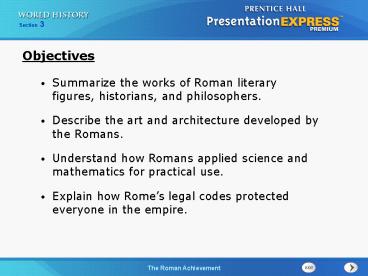PresentationExpress - PowerPoint PPT Presentation
1 / 15
Title:
PresentationExpress
Description:
Objectives Summarize the works of Roman literary figures, historians, and philosophers. Describe the art and architecture developed by the Romans. – PowerPoint PPT presentation
Number of Views:134
Avg rating:3.0/5.0
Title: PresentationExpress
1
Objectives
- Summarize the works of Roman literary figures,
historians, and philosophers. - Describe the art and architecture developed by
the Romans. - Understand how Romans applied science and
mathematics for practical use. - Explain how Romes legal codes protected everyone
in the empire.
2
Terms and People
- Virgil poet who wrote the epic poem The Aeneid
- satirize to make fun of
- mosaic picture made from chips of colored
stone or glass - engineering the application of science and
mathematics to develop useful structures and
machines
3
Terms and People (continued)
- aqueduct bridgelike stone structure that
carried water from the hills to the cities - Ptolemy astronomer-mathematician who proposed a
theory that the Earth was at the center of the
universe
4
How did advances in arts, learning, and the law
show the Romans high regard for cultural and
political achievements?
Through war and conquest, Roman generals carried
the achievements of Roman civilization to distant
lands. Yet the resulting civilization was not
simply Roman.
It blended Greek, Hellenistic, and Roman
achievements.
5
The blending of Greek, Hellenistic, and Roman
traditions produced Greco-Roman civilization.
- The Romans admired and adapted ideas from Greek
culture. - Travel during the Pax Romana spread this new
tradition.
6
In Virgils epic poem Aeneid, Aeneas escaped from
Troy to found Rome, linking Rome to Greek
culture. His goal was to increase patriotism.
Hellenistic philosophies such as Stoicism
impressed Romans. They stressed duty, acceptance
of ones fate, and concern for others.
7
Horace used wit to attack human folly.
Martial was so biting he had to use a fictitious
name to protect himself.
Livy recounted admiring tales of Horatius and
Cincinnatus.
Tacitus wrote of the loss of liberty.
8
Roman art and architecture grew and were adapted
from Etruscan and Greek roots.
- Artists and sculptures stressed realism and
sought to focus on the subjects character and
expression. - Some sculpture was highly idealistic, portraying
traits of power, grace, or strength.
9
Romans used art to beautify their homes. Mosaics
were created from small bits of stone or glass.
In A.D. 79. a volcano, Mt. Vesuvius, erupted,
burying Pompeii in ash, trapping residents but
preserving their homes and artwork.
10
Roman architecture stressed grandeur.
- Immense palaces, temples, and stadiums were
monuments to Roman power and dignity. - Rome improved on structural devices such as
columns and arches. They used concrete and built
huge domes. The most famous is the Pantheon.
11
Roman engineers built roads and aqueducts to
carry water to the cities.
There were public baths, and the rich had water
piped to their homes.
12
Eleven aqueducts brought water from the
surrounding hills into the city of Rome.
13
Roman scientists are generally remembered for
recording rather than creating new advances in
science.
Galen Ptolemy Pliny the Elder
Compiled an encyclopedia of all known medical knowledge that was used for centuries. Looked at the work of earlier astronomers. He suggested the Earth was the center of the universe, an error accepted for 1,500 years. Compiled volumes on geography, zoology, and botany.
14
Romes commitment to law is a legacy still
followed in the modern United States.
- Presumption of innocence
- Right to face ones accuser
- Need for evidence
- Judges fairly interpret laws
But the lower classes did receive harsher
punishments.
15
Section Review
Know It, Show It Quiz
QuickTake Quiz































